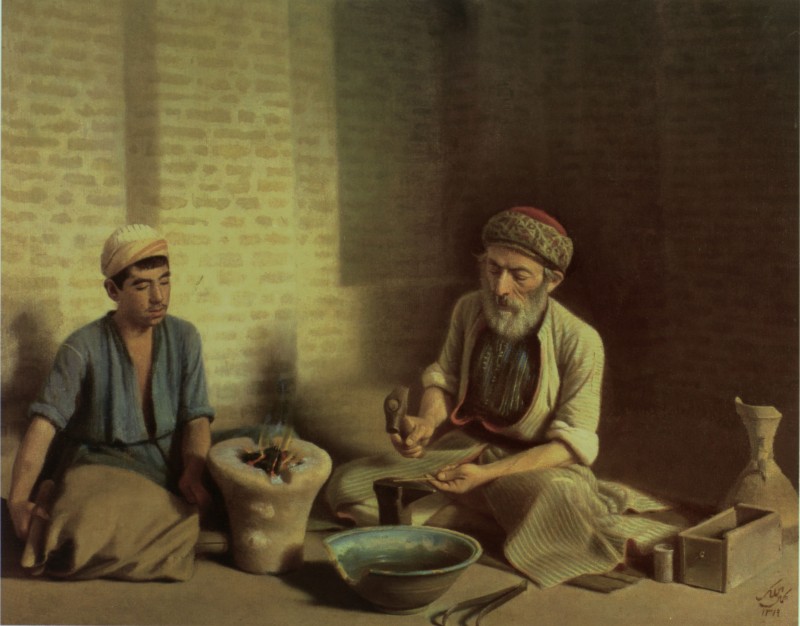|
Made In Denmark (season 1)
Made in Denmark is a Danish lifestyle and reality television program, in which a number of professionals in arts and crafts display their skills in their own area, and experiment with the other participant's materials. It debuted in 2015 on Danmarks Radio. The program was hosted by Ane Cortzen. Series overview Season One (2015) The first season of ''Made in Denmark'' featured 7 craftsmen Craftsman may refer to: A profession *Artisan, a skilled manual worker who makes items that may be functional or strictly decorative * Master craftsman, an artisan who has achieved such a standard that he may establish his own workshop and take ..., one of which would be the mentor in each episode. The mentor would teach the other 6 how to use their material, and in the end a famous personality within that field would judge the creations that the participants had made. The final episode was a finale in which all 7 craftsmen participated and a judge would declare the final winner. Participa ... [...More Info...] [...Related Items...] OR: [Wikipedia] [Google] [Baidu] |
Danmarks Radio
DR (), officially the Danish Broadcasting Corporation in English, is a Danish public-service radio and television broadcasting company. Founded in 1925 as a public-service organization, it is Denmark's oldest and largest electronic media enterprise. DR is a founding member of the European Broadcasting Union. DR was originally funded by a media licence, however since 2022, the media license has been replaced by an addition to the Danish income tax. Today, DR operates three television channels, all of which are distributed free-to-air via a nationwide DVB-T2 network. DR also operates seven radio channels. All are available nationally on DAB+ radio and online, with the four original stations also available on FM radio. History DR was founded on 1 April 1925 under the name of ''Radioordningen'', which was changed to ''Statsradiofonien'' in 1926, then to ''Danmarks Radio'' in 1959, and to ''DR'' in 1996. During the German occupation of Denmark in World War II, radio broadcas ... [...More Info...] [...Related Items...] OR: [Wikipedia] [Google] [Baidu] |
Brass
Brass is an alloy of copper (Cu) and zinc (Zn), in proportions which can be varied to achieve different mechanical, electrical, and chemical properties. It is a substitutional alloy: atoms of the two constituents may replace each other within the same crystal structure. Brass is similar to bronze, another copper alloy, that uses tin instead of zinc. Both bronze and brass may include small proportions of a range of other elements including arsenic (As), lead (Pb), phosphorus (P), aluminium (Al), manganese (Mn), and silicon (Si). Historically, the distinction between the two alloys has been less consistent and clear, and modern practice in museums and archaeology increasingly avoids both terms for historical objects in favor of the more general " copper alloy". Brass has long been a popular material for decoration due to its bright, gold-like appearance; being used for drawer pulls and doorknobs. It has also been widely used to make utensils because of its low melti ... [...More Info...] [...Related Items...] OR: [Wikipedia] [Google] [Baidu] |
Goldsmith
A goldsmith is a metalworker who specializes in working with gold and other precious metals. Nowadays they mainly specialize in jewelry-making but historically, goldsmiths have also made silverware, platters, goblets, decorative and serviceable utensils, and ceremonial or religious items. Goldsmiths must be skilled in forming metal through filing, soldering, sawing, forging, casting, and polishing. The trade has very often included jewelry-making skills, as well as the very similar skills of the silversmith. Traditionally, these skills had been passed along through apprenticeships; more recently jewelry arts schools, specializing in teaching goldsmithing and a multitude of skills falling under the jewelry arts umbrella, are available. Many universities and junior colleges also offer goldsmithing, silversmithing, and metal arts fabrication as a part of their fine arts curriculum. Gold Compared to other metals, gold is malleable, ductile, rare, and it is the only ... [...More Info...] [...Related Items...] OR: [Wikipedia] [Google] [Baidu] |
Sorø
Sorø () is a town in Sorø municipality in Region Sjælland on the island of Zealand (''Sjælland'') in east Denmark. The population is 7,999 (2022).BY3: Population 1. January by rural and urban areas, area and population density The Mobile Statbank from The municipal council and the regional council are located in Sorø. Sorø was founded in 1161 by , later the founder of |
Horn (anatomy)
A horn is a permanent pointed projection on the head of various animals that consists of a covering of keratin and other proteins surrounding a core of live bone. Horns are distinct from antlers, which are not permanent. In mammals, true horns are found mainly among the ruminant artiodactyls, in the families Antilocapridae ( pronghorn) and Bovidae ( cattle, goats, antelope etc.). Cattle horns arise from subcutaneous connective tissue (under the scalp) and later fuse to the underlying frontal bone. One pair of horns is usual; however, two or more pairs occur in a few wild species and in some domesticated breeds of sheep. Polycerate (multi-horned) sheep breeds include the Hebridean, Icelandic, Jacob, Manx Loaghtan, and the Navajo-Churro. Horns usually have a curved or spiral shape, often with ridges or fluting. In many species, only males have horns. Horns start to grow soon after birth and continue to grow throughout the life of the animal (except in pronghorns, whic ... [...More Info...] [...Related Items...] OR: [Wikipedia] [Google] [Baidu] |
Erik Bagger
Erik Bagger (born Erik Kristian Bagger; 21 April 1949) is a Danish goldsmith, industrial designer and businessman. Bagger is best known for its glass series Grand Cru, Opera and Rosendahl. Life and career Erik Bagger was trained as a goldsmith in 1970 and his full license was given after completing his apprenticeship working at Georg Jensen. In 1998 he became self-employed with the company Erik Bagger Design A/S and sold applied arts, which was referred to as Form Function. The same year he designs the gas lamp to Louisiana Museum of Modern Art's 40th anniversary by idea of the founder Knud W. Jensen. Erik Bagger established the design company Erik Bagger A/S with glass stemware designed for the Copenhagen Opera and Museum of Modern Art (MoMA) in New York City. He sold majority shareholding of Erik Bagger A/S to a private equity fund. Erik Bagger worked with his son, Frederik Bagger, in their joint private development company, as well as their studio, Erik Bagger Design ... [...More Info...] [...Related Items...] OR: [Wikipedia] [Google] [Baidu] |
Silversmithery
A silversmith is a metalworking, metalworker who crafts objects from silver. The terms ''silversmith'' and ''goldsmith'' are not exactly synonyms as the techniques, training, history, and guilds are or were largely the same but the end product may vary greatly as may the scale of objects created. History In the ancient Near East the value of silver to gold was lower, allowing a silversmith to produce objects and store these as stock. Ogden states that according to an edict written by Diocletian in 301 A.D., a silversmith was able to charge 75, 100, 150, 200, 250, or 300 ''denarii'' for material produce (per Roman pound). At that time, guilds of silversmiths formed to arbitrate disputes, protect its members' welfare and educate the public of the trade. Silversmiths in medieval Europe and England formed guilds and transmitted their tools and techniques to new generations via the apprentice tradition. Silver working guilds often maintained consistency and upheld standards at the ... [...More Info...] [...Related Items...] OR: [Wikipedia] [Google] [Baidu] |
Woodworking
Woodworking is the skill of making items from wood, and includes cabinet making (cabinetry and furniture), wood carving, joinery, carpentry, and woodturning. History Along with stone, clay and animal parts, wood was one of the first materials worked by early humans. Microwear analysis of the Mousterian stone tools used by the Neanderthals show that many were used to work wood. The development of civilization was closely tied to the development of increasingly greater degrees of skill in working these materials. Among early finds of wooden tools are the worked sticks from Kalambo Falls, Clacton-on-Sea and Lehringen. The spears from Schöningen (Germany) provide some of the first examples of wooden hunting gear. Flint tools were used for carving. Since Neolithic times, carved wooden vessels are known, for example, from the Linear Pottery culture wells at Kückhofen and Eythra. Examples of Bronze Age wood-carving include tree trunks worked into coffins from ... [...More Info...] [...Related Items...] OR: [Wikipedia] [Google] [Baidu] |
Blacksmithery
A blacksmith is a metalsmith who creates objects primarily from wrought iron or steel, but sometimes from other metals, by forging the metal, using tools to hammer, bend, and cut (cf. tinsmith). Blacksmiths produce objects such as gates, grilles, railings, light fixtures, furniture, sculpture, tools, agricultural implements, decorative and religious items, cooking utensils, and weapons. There was an historical distinction between the heavy work of the blacksmith and the more delicate operation of a whitesmith, who usually worked in gold, silver, pewter, or the finishing steps of fine steel. The place where a blacksmith works is called variously a smithy, a forge or a blacksmith's shop. While there are many people who work with metal such as farriers, wheelwrights, and armorers, in former times the blacksmith had a general knowledge of how to make and repair many things, from the most complex of weapons and armor to simple things like nails or lengths of chain. Etymology T ... [...More Info...] [...Related Items...] OR: [Wikipedia] [Google] [Baidu] |






